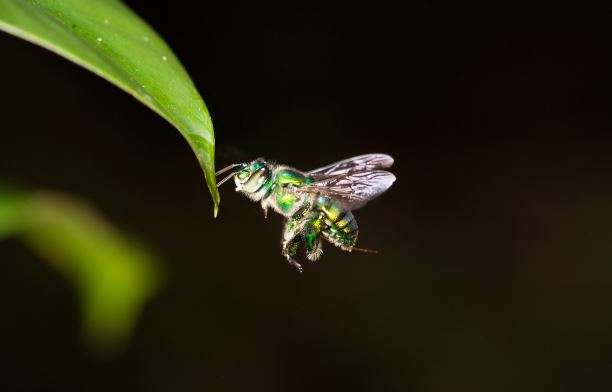Researchers reveal how orchid bees navigate through the depths of the rainforest

Scientists are untangling the mystery of how tropical bees are able to navigate through dense rainforests with brains the size of sesame seeds.
Orchid bees are a colourful tribe of insects that live in tropical and sub-tropical regions, often within the rainforests of Central and South America. These bees are known for travelling great distances in search of specific orchids to collect scents from.
Using the bright X-ray beam of the I13 Diamond-Manchester Imaging beamline, scientists have determined how the orchid bee's eyes capture the information it needs to fly through its complex habitat.
The international group, from Swedish, Australian, South African and UK institutions, found that the bee's three simple eyes – also known as ocelli – are more complex than previously imagined.
The three ocelli each have a retinal region which receives focused light from a different visual field. Other parts of each retina share a primarily unfocused view of a common region, creating a never-before-seen 'trinocular' visual field.
The focused visual fields of each eye are likely to provide information that helps bees stabilise their flight. Intriguingly, the individual light-sensing photoreceptors in each retina are also sensitive to light polarised in a specific direction, and their arrangement between the three retinae indicates that the ocelli could determine the polarisation properties of light viewed within the 'trinocular' visual field.
One benefit of such a method of 'polarisation analysis' would be to provide orchid bees with a highly sensitive compass reference by measuring celestial polarisation patterns, as this would assist them to navigate through the rainforest.
Dr Gavin Taylor from the University of Lund was one of the lead authors of the research. He highlights the significance of the group's findings to our understanding of insect biology and behaviour:
"Many insect species have ocelli but little is known about their function. Here we have made the unexpected finding that the ocelli of orchid bees appear to have two distinct roles, contributing to both flight control and the perception of polarised light.
"Flight through the rainforest is a demanding task and has resulted in orchid bees evolving these two specialisations to maximise the visual information they can extract from their ocelli."
Dr Andrew Bodey, Diamond Support Scientist on I13, also authored the paper and was heavily involved with the beamline experiments:
"The insights presented in the paper relied upon high quality data. We invested considerable time in optimising sample preparation, beamline equipment and imaging parameters so that we could minimise artefacts and produce tomograms of good contrast and high signal: noise."
These findings are part of a wider research project to determine the mechanisms that allow insects from different habitats to navigate their complex environments.
Harnessing the simplicity and efficiency with which insects move around their environments could provide us with new ways of designing improved navigation and stabilisation technology for unmanned aerial vehicles (UAVs).
The group opted to use X-ray microtomography because the technique is suited to producing three-dimensional micron-scale information for samples of this size. The beamline at the UK's synchrotron facility offered the group unprecedented resolution, helping them to look inside the tiny eyes that enable orchid bees' superior navigation.
The next step will be to perform similar studies on the prominent compound eyes of orchid bees, to investigate if these eyes also have specialisations for flight in the rainforest. The group also wants to understand how the visual information from both the compound eyes and ocelli combine to create the bee's visual world.
More information: Current Biology,
Journal information: Current Biology
Provided by Diamond Light Source
















